Physical Address
304 North Cardinal St.
Dorchester Center, MA 02124
Physical Address
304 North Cardinal St.
Dorchester Center, MA 02124
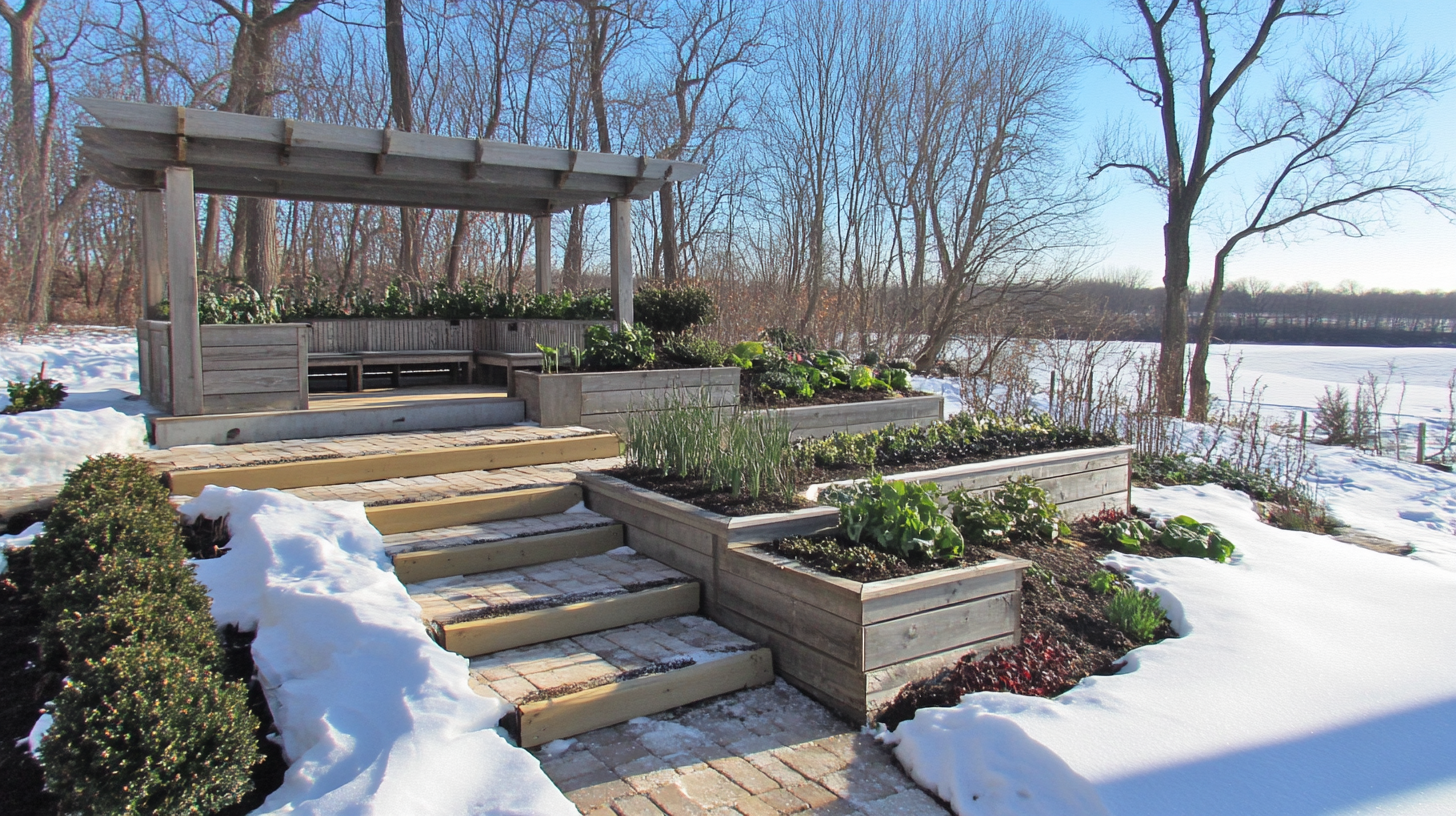
As winter draws near, it’s time to turn your garden into a charming haven. These creative garden ideas for winter will do the trick. Add hardy plants, glowing lights, and enjoy the quiet of a snow-covered scene. For inspiration, look to the Royal Horticultural Society and Garden Design Magazine. They have great tips for making an outdoor winter wonderland that everyone will love.
Moving your garden from fall into winter is a rewarding journey. It makes the beauty of both seasons stand out. By choosing the right colors, decorations, and plants, you can blend the special traits of fall and winter into your garden.
To start, use warm colors like deep reds, oranges, and golds. These echo the autumn leaves. Add these colors with flowers such as chrysanthemums and marigolds. You can also use seasonal planters and wreaths.
For winter, focus on evergreen plants and shrubs. They keep their green color even when it’s cold. Holly, boxwood, and juniper are great picks. They offer greenery against the snowy scenes of winter.
Link fall and winter with rustic wooden planters, fairy lights, and decorative lanterns. These items merge the warmth of fall with winter’s beauty. They make your garden inviting for holiday times.
Sources like Better Homes & Gardens, HGTV, and Martha Stewart show these ideas. They can help you make your garden a magical place. It will celebrate the changing seasons. Embrace the beauty of season-themed gardening, and your garden will be a lovely spot all winter.
As summer turns to autumn, it’s time to focus on prepping our gardens for winter. Picking the right plants and keeping the soil healthy in the cold are key. They make sure our gardens will be beautiful and cozy during winter.
Choosing winter-hardy plants is essential for a great autumn garden. These plants can handle cold weather and make your garden look stunning. Some top winter-hardy plants are:
Think about when each plant blooms and its leaves. This will help you keep color and texture in your garden all through autumn and winter.
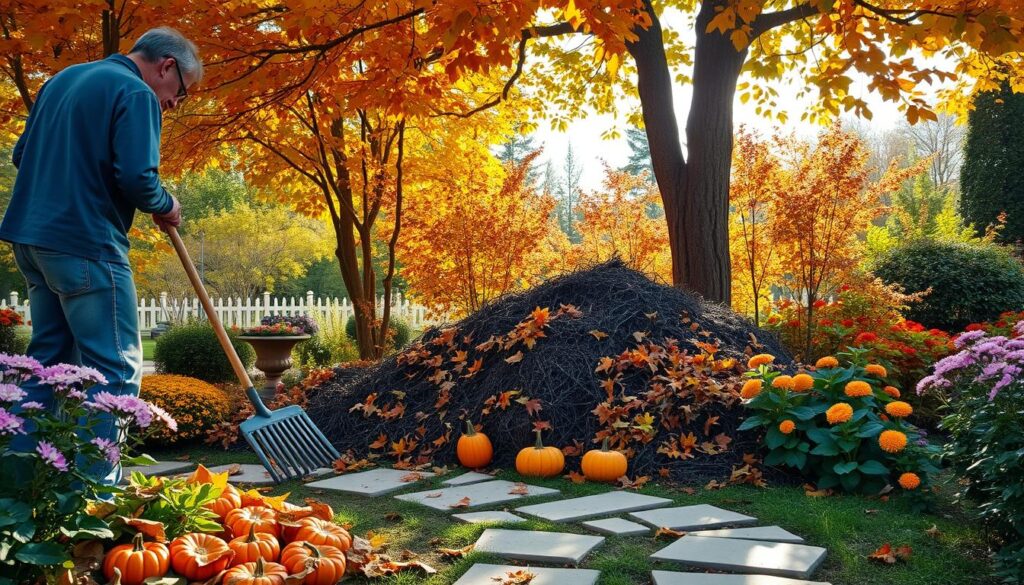
Keeping the soil healthy in the cold is vital for a great garden. As it gets colder, you need to ready your soil to help plants grow strong. Here are some ways to do that:
By doing these things, you’ll make your garden strong for the winter. This ensures your winter-friendly plants stay healthy and bright.
Gardening doesn’t have to stop when it gets cold. Focus on winter vegetable varieties to keep getting fresh homegrown winter produce. Kale, spinach, and carrots are great for cold weather. They grow well in winter, offering a healthy choice instead of store-bought veggies.
Don’t let the cold stop your garden-to-table meals. Growing vegetables in winter brings fresh harvests. It’s good for your health and wallet. You also get to enjoy the fruits of your labor, knowing exactly what’s in your food.
Choosing the right plants is crucial, say Mother Earth News experts. Go for hardy greens like Swiss chard and collard greens. Beets, turnips, and radishes can also survive the cold. According to Organic Gardening, these plants diversify your diet and keep it balanced.
Having different winter vegetable varieties makes your garden colorful and active. Crop rotation suggested by Seed Savers Exchange helps soil health and keeps pests away. Success in winter gardening comes from good preparation, care, and picking tough plants.
Make your garden productive all year with homegrown winter produce. Know the best growing conditions and choose the right vegetables. This lets you enjoy garden-to-table meals, even in winter.
Growing winter vegetables well means knowing the right cold weather techniques. Choosing the right varieties and using raised beds can lead to great harvests in the cold. Let’s look at some key winter gardening tips.
It’s crucial to pick vegetables that can stand cold weather. These veggies can handle frost and still grow strong. The American Horticultural Society and Farmers’ Almanac suggest some great choices:
These strong vegetables make sure you have fresh food all season. Plus, there are fewer bugs to worry about.
Raised beds are great for winter gardening. They help with draining and keeping the soil warm, which is key in the winter. Green America says they make managing soil and warmth easier. They also stop too much water from hurting the plants.
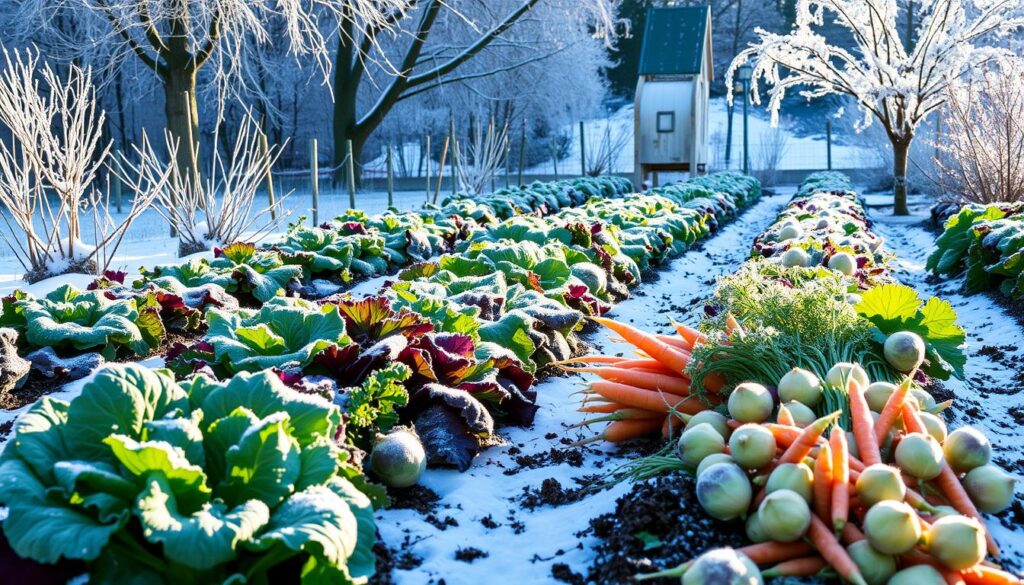
Raised beds also keep pests away better and use space well. With these winter gardening tips, your garden can succeed even when it’s very cold.
| Benefit | Raised Beds |
|---|---|
| Soil Temperature Regulation | Maintains warmth better |
| Improved Drainage | Prevents waterlogging |
| Pest Control | Enhanced protection |
| Space Efficiency | Effective use of garden area |
Use these methods and focus on tough veggies and raised bed gardening in winter. This way, you can have a great garden and enjoy your own produce during the cold months.
The tattoo plant brings a unique touch to winter gardens with its mesmerizing patterns. It stands out in the cold months. Adding such a unique plant can transform your garden’s look, making it stunning.
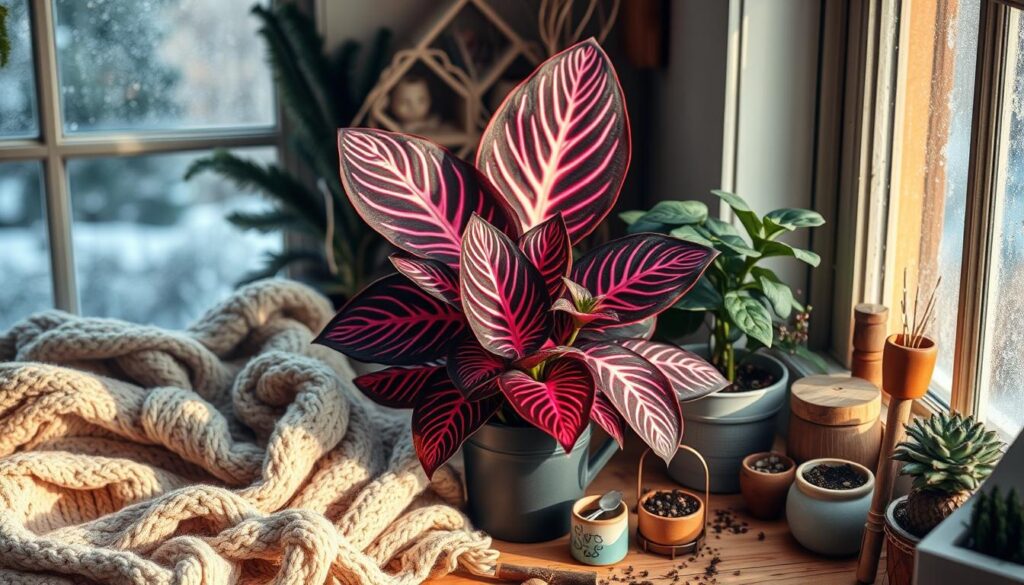
The tattoo plant enhances the winter garden with its detailed leaf patterns. Mixing it with other unique plants adds texture and depth to your garden’s look. It’s also tough against the cold.
For gardening lovers, the tattoo plant is a mix of beauty and strength. Following care tips ensures it thrives in cold weather. This lets it keep adding beauty to your garden.
| Aspect | Details |
|---|---|
| Temperature Tolerance | Cold-hardy, thrives in sheltered spots |
| Soil Requirements | Well-drained, moderately moist |
| Design Integration | Pairs well with other unique garden plants |
| Maintenance Tips | Regular mulching, moderate watering |
As autumn’s cool air arrives, it’s key to make your garden look good through winter. With the right gardening ideas, moving from fall to winter gets easy. This keeps your outdoor space beautiful and lasting.
Choosing the right plants is crucial for a garden that shines in both seasons. For example, ornamental grasses and evergreen shrubs recommended by Sunset Magazine look great all the time.
“Incorporating evergreen shrubs ensures not just greenery but structure and form that persists through the colder months,”
The folks at Sunset Magazine say. When mixed with winter flowers like pansies and mums from Gardeners’ World, your garden stays flexible.
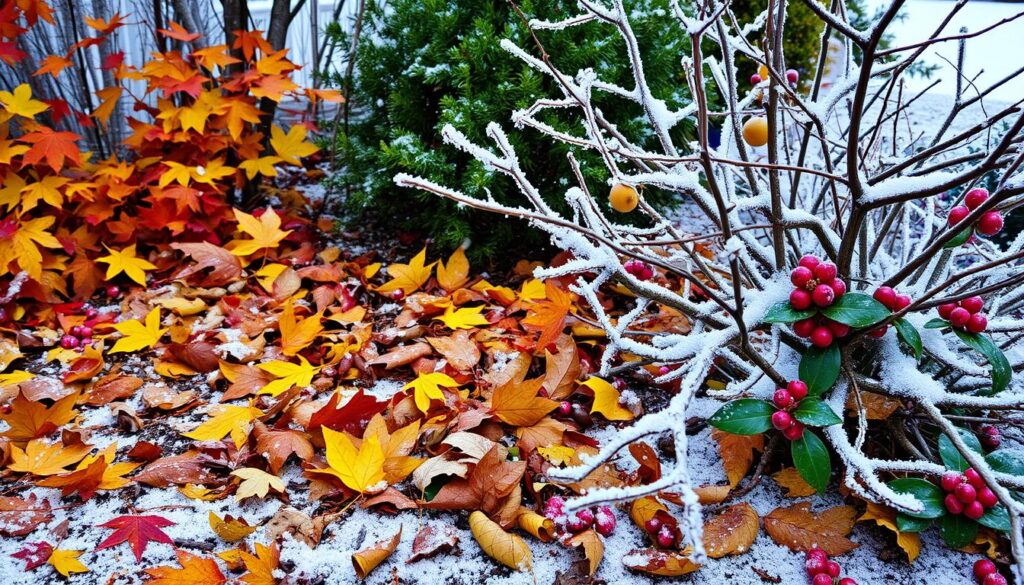
Another tip is to add elements with more than one use. The English Garden suggests mulch improves looks and protects the soil. It shields roots and keeps moisture in, helpful for gardening through fall and winter.
Want a list of plants perfect for both seasons? Here it is:
Adding these sturdy plants and smart gardening tips means your garden thrives from fall into winter. Get into adaptable gardening and enjoy your garden’s transition from autumn colors to winter’s calm beauty.
| Plant Type | Attributes | Season |
|---|---|---|
| Ornamental Grasses | Texture, Movement | Fall, Winter |
| Evergreen Shrubs | Structure, Greenery | Year-Round |
| Pansies | Vibrant Color | Fall, Early Winter |
| Mums | Fall Blooms | Fall, Early Winter |
Adding landscape rock to your winter garden can make it look great and work better. Rocks not only boost the garden’s look but also help with drainage and keep it insulated.
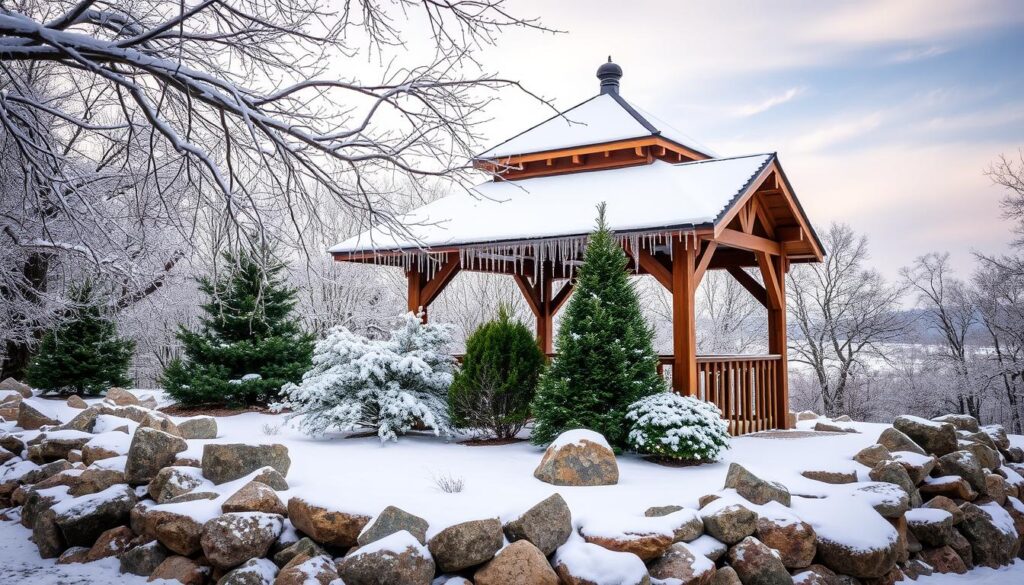
For a beautiful winter garden, pick landscape rocks that enhance your plants. Use different sizes and colors of rocks to add depth. Grouping rocks makes eye-catching spots in your garden.
Also, using small pebbles and gravel creates nice paths and edges. This makes your garden even more appealing.
Using rocks in your garden does more than just look good. They help with drainage and stop water from pooling. Rocks keep the soil from washing away, protect plant roots from cold, and keep moisture in.
Putting rocks near plants reduces the need for mulch. This makes taking care of your winter garden easier. In short, landscaping rocks are great for your winter garden. They make it look good and work better. Picking and placing rocks carefully can turn your garden into a peaceful, efficient space.
| Type of Rock | Benefit | Use Case |
|---|---|---|
| Granite | Durable, Varied Colors | Pathways, Focal Points |
| Limestone | Natural Look, Easy to Shape | Borders, Garden Beds |
| Slate | Sleek, Modern Appeal | Design Accents, Steps |
| Sandstone | Warmer Tones, Versatile | Terraces, Rockeries |
Getting your garden ready for the colder months is crucial. It’s a big part of winter homestead planning. If you use the right methods, your garden will last longer and do well, even when it’s really cold out. Here’s what you need to know to get your garden preparations for winter right.
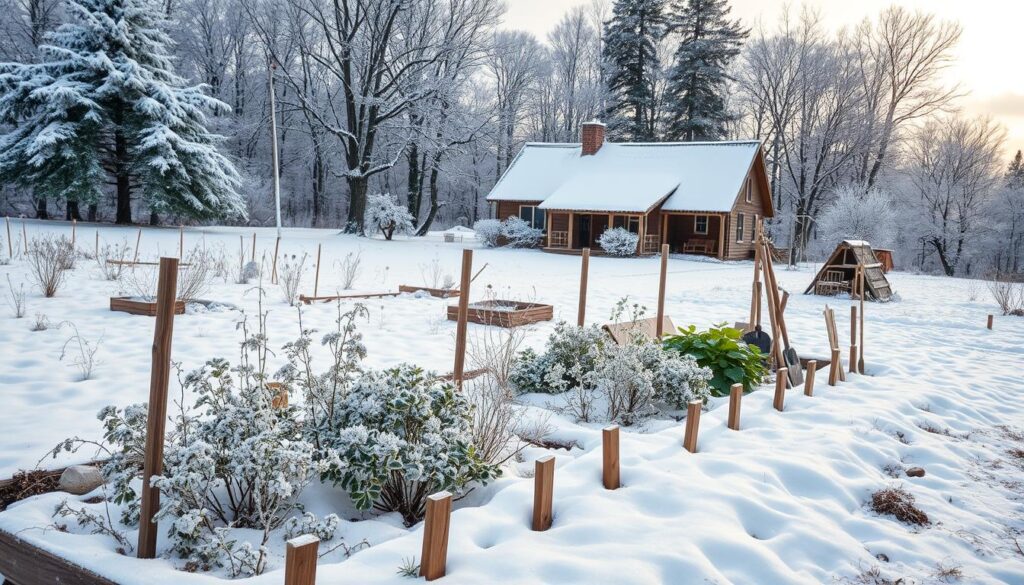
To really nail winter homestead planning, think about using cold frames. They make the growing season longer. And, choose plants that can handle the cold. Resources like Modern Farmer, Homestead and Chill, and The Old Farmer’s Almanac are great for info. They help keep gardens going all year.
| Winterizing Tips | Benefits |
|---|---|
| Cleaning up the garden | Prevents diseases and pests |
| Creating shelters with mulch and burlap | Protects plants from frost |
| Using cold frames | Extends growing season |
| Sustainable gardening practices | Maintains soil health |
Garden preparations for winter are key for a flourishing homestead garden. By sticking to these winter prep tips, homesteaders can have a garden that does well, even in winter.
Winter is great for starting exciting vegetable garden projects. These activities keep your gardening skills sharp during the colder months. They also help your garden stay vibrant and productive. Cold frames and DIY greenhouses are two popular projects. They’re both doable and ensure your garden yields fresh produce all year.
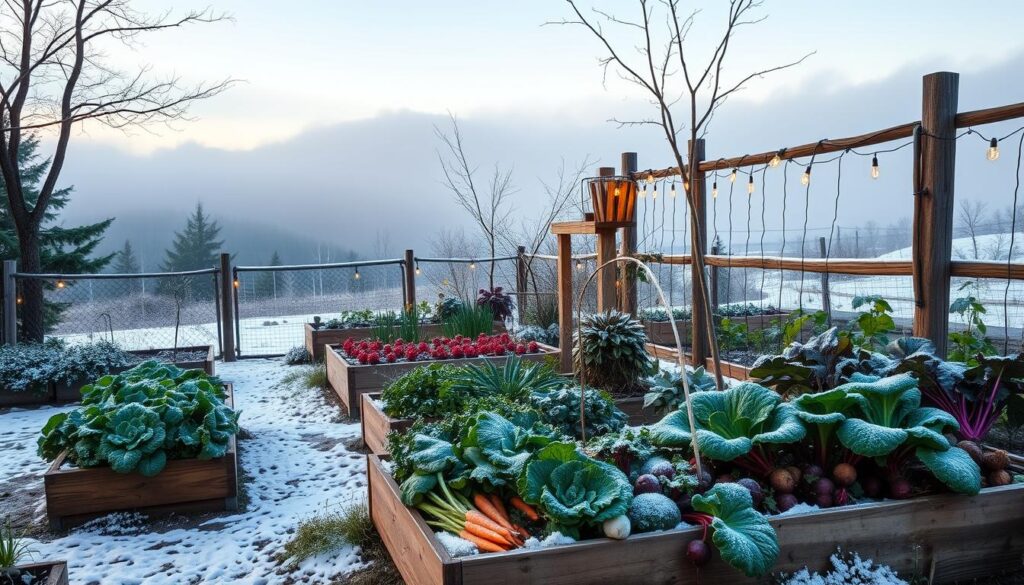
Building cold frames is a smart move to lengthen your growing season. A cold frame works like a small greenhouse. It uses the sun’s energy to keep plants warm and safe from frost. Here’s how to make one:
If you want to go bigger with your garden projects, try making a DIY greenhouse. A well-built greenhouse lets you grow different plants all year, no matter the weather. Here’s a straightforward plan to follow:
Both cold frames and DIY greenhouses will improve your winter gardening. These methods are backed by expert gardeners. Whether you’re getting ideas from the DIY Network or Rodale’s Organic Life, your garden will flourish year-round.
Planning your fall garden boosts your winter harvest, giving you fresh veggies even when it’s cold. This guide shows the best veggies to plant in fall for a great winter harvest.
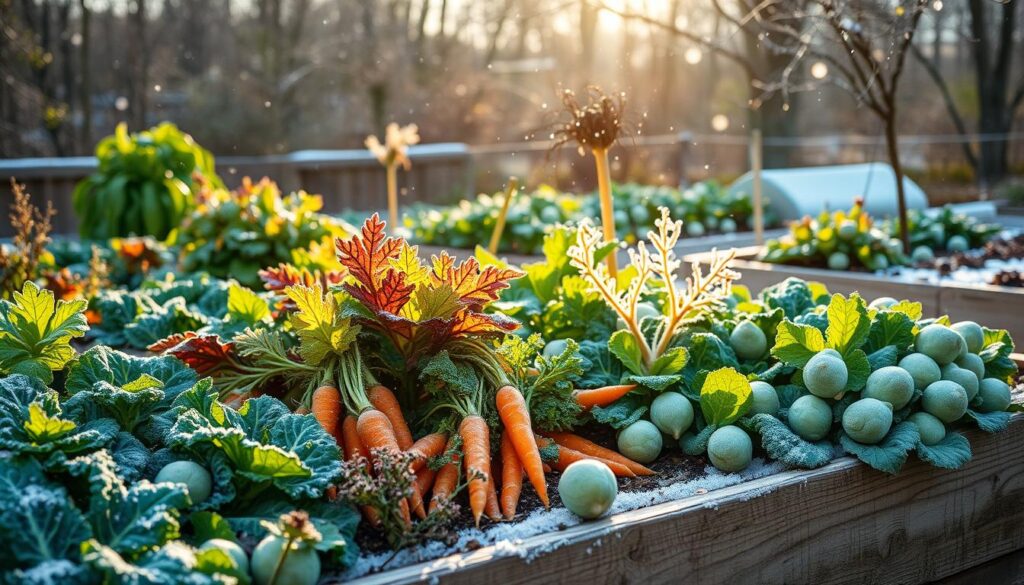
For a great harvest, timing and how you plant are key. Here we talk about important fall veggies and how to grow them right.
“By injecting some thoughtful planning and the right choices of crops, your winter garden can flourish even as temperatures drop.” – Gardenate
| Vegetable | Planting Time | Care Instructions | Expected Yield |
|---|---|---|---|
| Kale | Early Fall | Water regularly, add mulch | 3-4 months after planting |
| Brussels Sprouts | Late Summer to Early Fall | Requires staking, frost-tolerant | 4-5 months after planting |
| Garlic | Mid to Late Fall | Ensure well-drained soil, minimal watering | Late Spring to Early Summer |
| Carrots | Early to Mid Fall | Thin plants, consistent watering | 2-3 months after planting |
| Spinach | Early Fall | Regular watering, shade in hot climates | 1-2 months after planting |
This table is your guide for planting veggies in fall. It helps you plan and care for your garden to get a steady supply in winter.
With the right choices and care, your winter garden will thrive. Places like Territorial Seed Company and Johnny’s Selected Seeds offer great tips for picking the best crops for cold weather.
Transform your garden into a captivating wonderland this winter. Creative design elements make your outdoor space stunning, even in the cold. This magical transformation brings joy and beauty to the season.
Evergreens keep your garden green all year. Pines, spruce, and boxwood stand strong in winter, providing texture and color. Place evergreens in key areas to keep your garden beautiful.
Lighting can highlight your garden’s best features in winter. String lights and LED path lights bring warmth and magic. It’s not just about beauty; it also makes your outdoor space safer.
Water features look stunning against a frosty backdrop. Ponds, fountains, or waterfalls add tranquility and beauty. Just remember, it’s crucial to care for them in winter to prevent freezing.
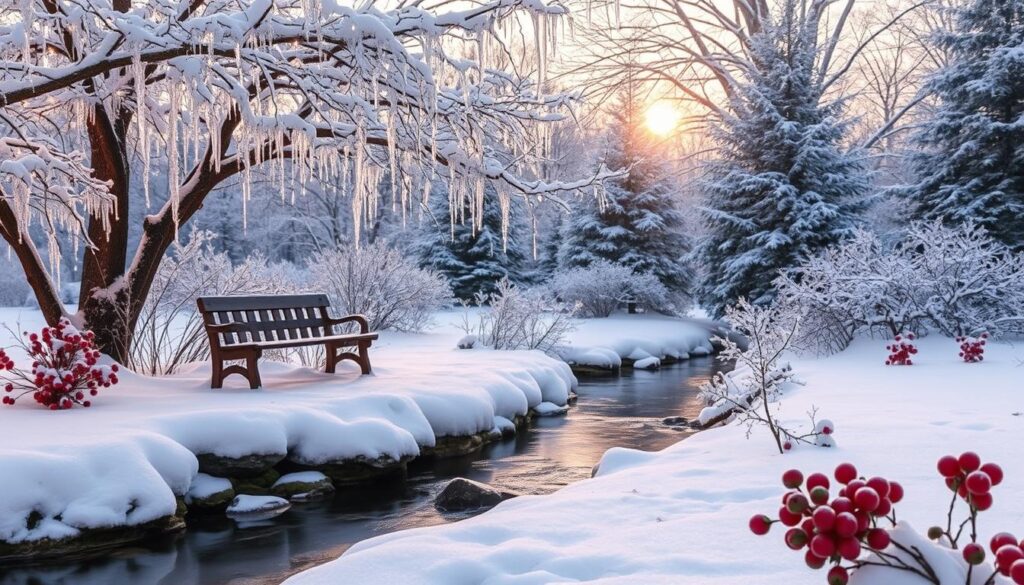
Choose fall veggies that love the cold to make your garden shine. These plants grow well in cool weather and their taste gets better with the chill. It’s wise to pick plants suited to your climate for a great harvest in fall.
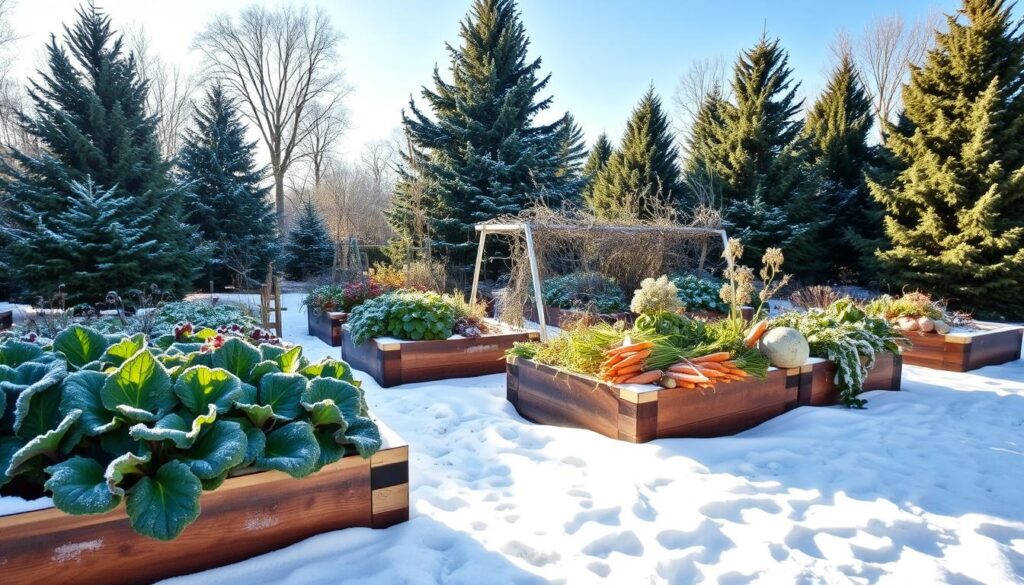
Kale is great for fall, getting tastier as it cools. Brussels sprouts also sweeten up with frost. Beets and carrots are perfect for shorter days, growing strong in cooler weather.
Knowing when the first frost hits your area helps pick the right veggies. This guide will show you the best choices for a cooler climate garden.
| Vegetable | Optimal Planting Time | Growing Tips |
|---|---|---|
| Kale | Late Summer to Early Fall | Plant in compost-rich soil; mulch to retain moisture. |
| Brussels Sprouts | Mid to Late Summer | Stagger plantings to extend harvest; support tall stalks. |
| Beets | Late Summer to Early Fall | Thin seedlings for better root development; keep soil moist. |
| Carrots | Late Summer to Early Fall | Ensure deep, loose soil; maintain consistent watering. |
Choosing the right plants for cooler weather makes your garden thrive. Use covers to shield plants from frost. With the right care, your fall garden will be full of life.
Keeping your garden going during the winter is tough, especially in small areas. By planting continuously, city dwellers can have a lively winter garden without using much space. We’ll explore how to keep your winter garden productive, even if you don’t have much room.
Container and vertical gardening are key for winter veggies in small places. Kale, spinach, and dwarf carrots do great in city gardens. They handle cold well and fit in tight spaces, perfect for balconies and small yards. Using trellises or stacked planters helps save more space.
Continuous planting keeps your winter garden giving. Planting spinach every two weeks means you’ll always have some ready to pick. Pairing quick growers like radishes with slower ones like beets makes the most of your space and time.
DIY cold frames or mini greenhouses can make your growing season longer and protect your plants from cold. According to Urban Garden Magazine, Balcony Garden Web, and City Farmer News, these tricks boost your garden’s yield, even in tight city spaces. With the right methods, your winter gardening can thrive, offering lots of produce.